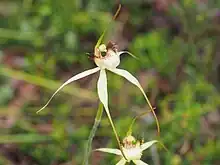| Bussell's spider orchid | |
|---|---|
 | |
| Caladenia busselliana growing near Dunsborough | |
| Scientific classification | |
| Kingdom: | Plantae |
| Clade: | Tracheophytes |
| Clade: | Angiosperms |
| Clade: | Monocots |
| Order: | Asparagales |
| Family: | Orchidaceae |
| Subfamily: | Orchidoideae |
| Tribe: | Diurideae |
| Genus: | Caladenia |
| Species: | C. busselliana |
| Binomial name | |
| Caladenia busselliana Hopper & A.P.Br.[1] | |
Caladenia busselliana, commonly known as Bussell's spider orchid, is a plant in the orchid family Orchidaceae and is endemic to a small area in the south-west of Western Australia. It is a rare orchid with an erect, hairy leaf and up to three pale yellow flowers. Only about fifty specimens are known and it is threatened by habitat destruction and by too-frequent or too infrequent bushfires.

Description
Caladenia busselliana is a terrestrial, perennial, deciduous, herb with an underground tuber and a single erect, hairy leaf 20–30 cm (8–10 in) long and 5–10 mm (0.2–0.4 in) wide. There are up to three pale yellow flowers on a stem 20–30 cm (8–10 in) high. The flowers are 6–10 cm (2–4 in) long and 5–8 cm (2–3 in) wide. The lateral sepals and petals spread widely and the sepals are thickened. The labellum is pale yellow to white and lacks the red tip common to similar spider orchids. The sides of the labellum have narrow teeth or calli which have a "clubbed" end. There are four or more rows of red-tipped calli along the centre of the labellum. Flowering occurs between September and October and is followed by a non-fleshy, dehiscent capsule containing a large number of seeds.[2][3][4]
Taxonomy and naming
Caladenia busselliana was first formally described by Stephen Hopper and Andrew Brown in 2001 from a specimen collected by Greg Bussell near Quindalup and the description was published in Nuytsia.[1] The specific epithet (busselliana) honours the collector of the type specimen.[2][3]
Distribution and habitat
Bussell's spider orchid grows in swampy jarrah forest and marri woodland, often with green kangaroo paw, (Anigozanthos viridis) and the more common swamp spider orchid (Caladenia paludosa). It is only known from two small areas near Vasse and Yallingup at the northern end of the Leeuwin-Naturaliste ridge in the Swan Coastal Plain biogeographic region.[2][3][5][6]
Conservation
Caladenia busselliana is classified as "endangered" under the Australian Government Environment Protection and Biodiversity Conservation Act 1999 (EPBC Act) and as "rare flora" under the Western Australian Wildlife Conservation Act 1950.[5][6]
References
- 1 2 "Caladenia busselliana". APNI. Retrieved 31 October 2016.
- 1 2 3 Brown, Andrew; Dixon, Kingsley; French, Christopher; Brockman, Garry (2013). Field guide to the orchids of Western Australia : the definitive guide to the native orchids of Western Australia. Simon Nevill Publications. p. 100. ISBN 9780980348149.
- 1 2 3 Hoffman, Noel; Brown, Andrew (2011). Orchids of South-West Australia (3rd ed.). Gooseberry Hill: Noel Hoffman. p. 126. ISBN 9780646562322.
- ↑ "Caladenia". Royal Botanic Gardens Victoria. Retrieved 31 October 2016.
- 1 2 Patten, Julie; Webb, Andrew; Batty, Andrew. "Bussell's spider orchid (Caladenia busselliana) recovery plan" (PDF). Australian Government Department of the Environment. Retrieved 31 October 2016.
- 1 2 "Caladenia busselliana". FloraBase. Western Australian Government Department of Biodiversity, Conservation and Attractions.
